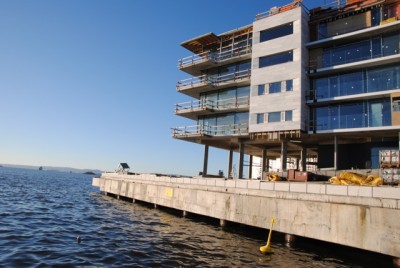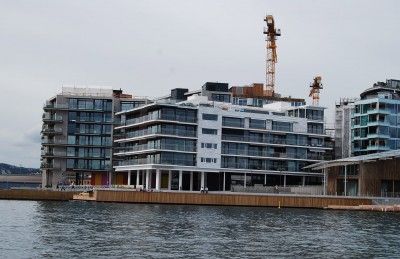More economists are predicting that Norway’s high prices for homes and apartments will fall, after the first signs of a dip emerged in September. That didn’t stop one wealthy investor, however, from paying more than NOK 200 million to create a huge residential unit on the top floors of a waterfront complex in Oslo.

“Some people choose to invest large sums in a Picasso or a Munch (painting),” investor and businessman Olav Nils Sunde told newspaper Dagens Næringsliv (DN) shortly after release of the official registration of his residential purchase. “I have chosen to invest in an outstanding and unique residence at Tjuvholmen. Even though this has become an extremely expensive investment, and much higher than planned, I’m convinced that it will be a good investment in the long term.”
Sunde has paid NOK 236.5 million (nearly USD 40 million) for several units on the fourth and fifth floors of Tjuvholmen’s Kavringen Brygge, plus the building’s entire roof terrace and its interior areas. He’s combining it all to create a flat that’s nearly 1,200 square meters (12,000 square feet), meaning that he’s paying NOK 200,000 per square meter in a market where NOK 60,000 is considered prime. His monthly fees to the homeowners’ association alone will amount to NOK 60,000, reported DN.
He’s not even sure he’ll move into the huge apartment when it’s finally completed, even though he can monitor the comings and goings of the Color Line cruise ferries he controls from his terraces, since its terminal is located adjacent to Tjuvholmen. His investment company is also located at nearby Aker Brygge.

“I can understand that many will think it’s not right to use so much money on such an investment,” Sunde told DN. “But compared to my other investments in factories, machines, ships and other operations of nearly NOK 14 billion, this investment is less than 2 percent of my total portfolio.”
Sunde’s new condominium in a prime location at Tjuvholmen, with its sweeping views down the Oslo Fjord, is clearly in a class of its own and can’t be considered representative of the market. Tjuvholmen has commanded high prices, but the steady overall rise in residential real estate prices over the past several years seems to be coming to an end. A 1.4 percent decline in the average price of residential sales from August to September was bigger than expected. In Oslo, the month-to-month decline was 1.6 percent, but prices were still up 3.7 percent from September of last year.
That’s smaller than recent annual increases, though, and now some economists warn the market is “out of balance.” Peter Hermansrud of Swedbank First Securities told DN over the weekend that Norway, sooner or later, will experience the same as other countries have after long periods of rapid appreciation. The market will turn (some think it already has) and prices will decline.
‘Mood change’
“We noticed a change in the mood almost from one weekend of open houses to the next, just before the summer,” one real estate broker told DN. Since then, traffic at property showings has declined, the first noticeable price decline was registered and some high-end properties, especially in the holiday home segment, have been taken off the market.
Monday’s release of the new proposed state budget may also put downwards pressure on prices, reported state broadcaster NRK on Tuesday, since it removes some tax incentives for real estate speculators. The budget is up for negotiation, but may also include new capital gains taxes on some sales.
Expected declines in the price of oil can also affect Norway’s economy and business climate, and leave buyers less willing or able to pay current prices. Prices have risen so high, Hermansrud told DN, that “right now the housing market is out of balance. I think it’s about 40 percent certain that this is the beginning of something that will last for a long time.” A price slide can continue for four or five years, he thinks, before prices start to rise again.
Market ‘correction’
Brokers call it “a correction phase” that started early this year. From annual price rises of 7-10 percent, this year’s is expected to land at 4.5-5 percent on a nationwide basis, with regional variations. Many, especially first-time buyers, will welcome a decline, while others think the correction is healthy because the market has been overheated.
There’s one area where prices might rise, and that’s in popular holiday areas where the incoming government has proposed doing away with local rules that can require a buyer to live in a home, apartment or cottage (called boplikt) instead of using it as a holiday property. That may raise prices since the holiday market is higher than local residential markets, but it’s by no means certain the Conservatives-led proposal will win approval in Parliament.
newsinenglish.no/Nina Berglund

